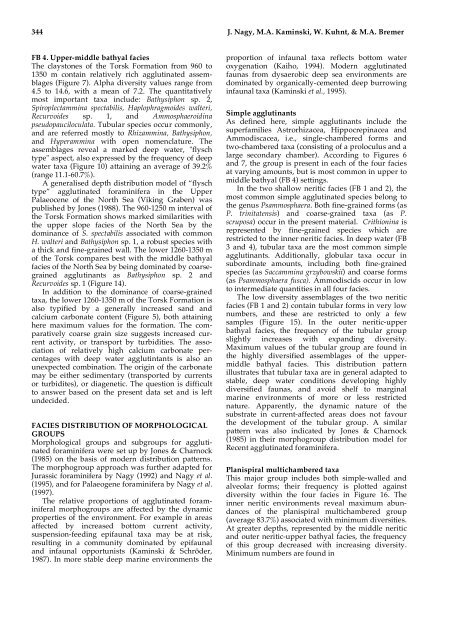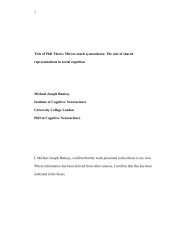Agglutinated foraminifera from neritic to bathyal facies in the ...
Agglutinated foraminifera from neritic to bathyal facies in the ...
Agglutinated foraminifera from neritic to bathyal facies in the ...
Create successful ePaper yourself
Turn your PDF publications into a flip-book with our unique Google optimized e-Paper software.
344 J. Nagy, M.A. Kam<strong>in</strong>ski, W. Kuhnt, & M.A. Bremer<br />
FB 4. Upper-middle <strong>bathyal</strong> <strong>facies</strong><br />
The clays<strong>to</strong>nes of <strong>the</strong> Torsk Formation <strong>from</strong> 960 <strong>to</strong><br />
1350 m conta<strong>in</strong> relatively rich agglut<strong>in</strong>ated assemblages<br />
(Figure 7). Alpha diversity values range <strong>from</strong><br />
4.5 <strong>to</strong> 14.6, with a mean of 7.2. The quantitatively<br />
most important taxa <strong>in</strong>clude: Bathysiphon sp. 2,<br />
Spiroplectamm<strong>in</strong>a spectabilis, Haplophragmoides walteri,<br />
Recurvoides sp. 1, and Ammosphaeroid<strong>in</strong>a<br />
pseudopauciloculata. Tubular species occur commonly,<br />
and are referred mostly <strong>to</strong> Rhizamm<strong>in</strong>a, Bathysiphon,<br />
and Hyperamm<strong>in</strong>a with open nomenclature. The<br />
assemblages reveal a marked deep water, "flysch<br />
type" aspect, also expressed by <strong>the</strong> frequency of deep<br />
water taxa (Figure 10) atta<strong>in</strong><strong>in</strong>g an average of 39.2%<br />
(range 11.1-60.7%).<br />
A generalised depth distribution model of “flysch<br />
type” agglut<strong>in</strong>ated <strong>foram<strong>in</strong>ifera</strong> <strong>in</strong> <strong>the</strong> Upper<br />
Palaeocene of <strong>the</strong> North Sea (Vik<strong>in</strong>g Graben) was<br />
published by Jones (1988). The 960-1250 m <strong>in</strong>terval of<br />
<strong>the</strong> Torsk Formation shows marked similarities with<br />
<strong>the</strong> upper slope <strong>facies</strong> of <strong>the</strong> North Sea by <strong>the</strong><br />
dom<strong>in</strong>ance of S. spectabilis associated with common<br />
H. walteri and Bathysiphon sp. 1, a robust species with<br />
a thick and f<strong>in</strong>e-gra<strong>in</strong>ed wall. The lower 1260-1350 m<br />
of <strong>the</strong> Torsk compares best with <strong>the</strong> middle <strong>bathyal</strong><br />
<strong>facies</strong> of <strong>the</strong> North Sea by be<strong>in</strong>g dom<strong>in</strong>ated by coarsegra<strong>in</strong>ed<br />
agglut<strong>in</strong>ants as Bathysiphon sp. 2 and<br />
Recurvoides sp. 1 (Figure 14).<br />
In addition <strong>to</strong> <strong>the</strong> dom<strong>in</strong>ance of coarse-gra<strong>in</strong>ed<br />
taxa, <strong>the</strong> lower 1260-1350 m of <strong>the</strong> Torsk Formation is<br />
also typified by a generally <strong>in</strong>creased sand and<br />
calcium carbonate content (Figure 5), both atta<strong>in</strong><strong>in</strong>g<br />
here maximum values for <strong>the</strong> formation. The comparatively<br />
coarse gra<strong>in</strong> size suggests <strong>in</strong>creased current<br />
activity, or transport by turbidities. The association<br />
of relatively high calcium carbonate percentages<br />
with deep water agglut<strong>in</strong>tants is also an<br />
unexpected comb<strong>in</strong>ation. The orig<strong>in</strong> of <strong>the</strong> carbonate<br />
may be ei<strong>the</strong>r sedimentary (transported by currents<br />
or turbidites), or diagenetic. The question is difficult<br />
<strong>to</strong> answer based on <strong>the</strong> present data set and is left<br />
undecided.<br />
FACIES DISTRIBUTION OF MORPHOLOGICAL<br />
GROUPS<br />
Morphological groups and subgroups for agglut<strong>in</strong>ated<br />
<strong>foram<strong>in</strong>ifera</strong> were set up by Jones & Charnock<br />
(1985) on <strong>the</strong> basis of modern distribution patterns.<br />
The morphogroup approach was fur<strong>the</strong>r adapted for<br />
Jurassic <strong>foram<strong>in</strong>ifera</strong> by Nagy (1992) and Nagy et al.<br />
(1995), and for Palaeogene <strong>foram<strong>in</strong>ifera</strong> by Nagy et al.<br />
(1997).<br />
The relative proportions of agglut<strong>in</strong>ated <strong>foram<strong>in</strong>ifera</strong>l<br />
morphogroups are affected by <strong>the</strong> dynamic<br />
properties of <strong>the</strong> environment. For example <strong>in</strong> areas<br />
affected by <strong>in</strong>creased bot<strong>to</strong>m current activity,<br />
suspension-feed<strong>in</strong>g epifaunal taxa may be at risk,<br />
result<strong>in</strong>g <strong>in</strong> a community dom<strong>in</strong>ated by epifaunal<br />
and <strong>in</strong>faunal opportunists (Kam<strong>in</strong>ski & Schröder,<br />
1987). In more stable deep mar<strong>in</strong>e environments <strong>the</strong><br />
proportion of <strong>in</strong>faunal taxa reflects bot<strong>to</strong>m water<br />
oxygenation (Kaiho, 1994). Modern agglut<strong>in</strong>ated<br />
faunas <strong>from</strong> dysaerobic deep sea environments are<br />
dom<strong>in</strong>ated by organically-cemented deep burrow<strong>in</strong>g<br />
<strong>in</strong>faunal taxa (Kam<strong>in</strong>ski et al., 1995).<br />
Simple agglut<strong>in</strong>ants<br />
As def<strong>in</strong>ed here, simple agglut<strong>in</strong>ants <strong>in</strong>clude <strong>the</strong><br />
superfamilies Astrorhizacea, Hippocrep<strong>in</strong>acea and<br />
Ammodiscacea, i.e., s<strong>in</strong>gle-chambered forms and<br />
two-chambered taxa (consist<strong>in</strong>g of a proloculus and a<br />
large secondary chamber). Accord<strong>in</strong>g <strong>to</strong> Figures 6<br />
and 7, <strong>the</strong> group is present <strong>in</strong> each of <strong>the</strong> four <strong>facies</strong><br />
at vary<strong>in</strong>g amounts, but is most common <strong>in</strong> upper <strong>to</strong><br />
middle <strong>bathyal</strong> (FB 4) sett<strong>in</strong>gs.<br />
In <strong>the</strong> two shallow <strong>neritic</strong> <strong>facies</strong> (FB 1 and 2), <strong>the</strong><br />
most common simple agglut<strong>in</strong>ated species belong <strong>to</strong><br />
<strong>the</strong> genus Psammosphaera. Both f<strong>in</strong>e-gra<strong>in</strong>ed forms (as<br />
P. tr<strong>in</strong>itatensis) and coarse-gra<strong>in</strong>ed taxa (as P.<br />
scruposa) occur <strong>in</strong> <strong>the</strong> present material. Crithion<strong>in</strong>a is<br />
represented by f<strong>in</strong>e-gra<strong>in</strong>ed species which are<br />
restricted <strong>to</strong> <strong>the</strong> <strong>in</strong>ner <strong>neritic</strong> <strong>facies</strong>. In deep water (FB<br />
3 and 4), tubular taxa are <strong>the</strong> most common simple<br />
agglut<strong>in</strong>ants. Additionally, globular taxa occur <strong>in</strong><br />
subord<strong>in</strong>ate amounts, <strong>in</strong>clud<strong>in</strong>g both f<strong>in</strong>e-gra<strong>in</strong>ed<br />
species (as Saccamm<strong>in</strong>a grzybowskii) and coarse forms<br />
(as Psammosphaera fusca). Ammodiscids occur <strong>in</strong> low<br />
<strong>to</strong> <strong>in</strong>termediate quantities <strong>in</strong> all four <strong>facies</strong>.<br />
The low diversity assemblages of <strong>the</strong> two <strong>neritic</strong><br />
<strong>facies</strong> (FB 1 and 2) conta<strong>in</strong> tubular forms <strong>in</strong> very low<br />
numbers, and <strong>the</strong>se are restricted <strong>to</strong> only a few<br />
samples (Figure 15). In <strong>the</strong> outer <strong>neritic</strong>-upper<br />
<strong>bathyal</strong> <strong>facies</strong>, <strong>the</strong> frequency of <strong>the</strong> tubular group<br />
slightly <strong>in</strong>creases with expand<strong>in</strong>g diversity.<br />
Maximum values of <strong>the</strong> tubular group are found <strong>in</strong><br />
<strong>the</strong> highly diversified assemblages of <strong>the</strong> uppermiddle<br />
<strong>bathyal</strong> <strong>facies</strong>. This distribution pattern<br />
illustrates that tubular taxa are <strong>in</strong> general adapted <strong>to</strong><br />
stable, deep water conditions develop<strong>in</strong>g highly<br />
diversified faunas, and avoid shelf <strong>to</strong> marg<strong>in</strong>al<br />
mar<strong>in</strong>e environments of more or less restricted<br />
nature. Apparently, <strong>the</strong> dynamic nature of <strong>the</strong><br />
substrate <strong>in</strong> current-affected areas does not favour<br />
<strong>the</strong> development of <strong>the</strong> tubular group. A similar<br />
pattern was also <strong>in</strong>dicated by Jones & Charnock<br />
(1985) <strong>in</strong> <strong>the</strong>ir morphogroup distribution model for<br />
Recent agglut<strong>in</strong>ated <strong>foram<strong>in</strong>ifera</strong>.<br />
Planispiral multichambered taxa<br />
This major group <strong>in</strong>cludes both simple-walled and<br />
alveolar forms; <strong>the</strong>ir frequency is plotted aga<strong>in</strong>st<br />
diversity with<strong>in</strong> <strong>the</strong> four <strong>facies</strong> <strong>in</strong> Figure 16. The<br />
<strong>in</strong>ner <strong>neritic</strong> environments reveal maximum abundances<br />
of <strong>the</strong> planispiral multichambered group<br />
(average 83.7%) associated with m<strong>in</strong>imum diversities.<br />
At greater depths, represented by <strong>the</strong> middle <strong>neritic</strong><br />
and outer <strong>neritic</strong>-upper <strong>bathyal</strong> <strong>facies</strong>, <strong>the</strong> frequency<br />
of this group decreased with <strong>in</strong>creas<strong>in</strong>g diversity.<br />
M<strong>in</strong>imum numbers are found <strong>in</strong>
















